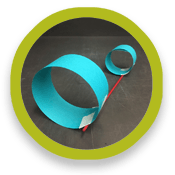SCIENCE EXPERIMENTS FOR KIDS
HOW TO MAKE HOOPSTERS
Take your paper airplane-making up a notch with these cool flying hoops
You may have folded paper into an airplane, but paper loops can also glide, and sometimes do tricks! So give your flight an upgrade with these simple soaring strips. Because paper airplanes are so five minutes ago.
Using paper, a straw and some tape, your aspiring aviators will learn about the principle of lift and what makes things stay up in the air. Prepare for takeoff!
GATHER THIS:
- Card stock paper cut into strips
- Plastic straw, not bendy
- Scissors
- Tape
THEN DO THIS:
- Tape a strip of paper into a loop.
- With another strip of paper, make another loop smaller than the first.
- Tape the loops slightly apart to opposite ends of a straw. Tape both loops in the same plane so that the loops are aligned (as if looking through a telescope).
- Hold the hoopster in the middle of the straw with the smaller hoop in front. Throw it like a spear. It may take a little practice, but once you get the hang of it, your hoopster will glide!
- Try redesigning your hoopster by adding paper clips to the loops, adding more loops in different orientations, or even adding straws to make an extra-long hoopster.

ASK THIS:
- How does an extra-long hoopster behave differently?
- How is the glide different with loops facing in all different directions?
- How can you make your hoopster turn in a certain direction?
- How does your hoopster’s glide change if you have loops closer together or further apart?
WHAT IS HAPPENING?
Lift! Bernoulli’s Principle defines the relationship between air speed and air pressure; higher speed equals lower pressure. If air moves faster over the top of an object, it creates lower air pressure and lift! As the hoopster falls forward through the air, the air travels faster over the top of the loops than through the loops. This difference in pressure generates the lift that makes the hoopster glide!
A larger loop creates more drag or wind resistance. Placing a larger loop in the back of the hoopster allows the smaller loop at the front to move faster, and the hoopster to glide more smoothly. Loops placed in the reverse positions will create a more erratic flight path.
WHAT THIS TEACHES:
Skills: Fine motor skills, predictions, observation
Themes: Lift, drag, flight
Join the CuriOdyssey Community
LOCATION
1651 Coyote Point Drive
San Mateo, CA 94401
Ohlone Land Acknowledgement
650-342-7755
info@curiodyssey.org
CuriOdyssey is a 501(c)(3) non-profit, Tax ID 94-1262434




